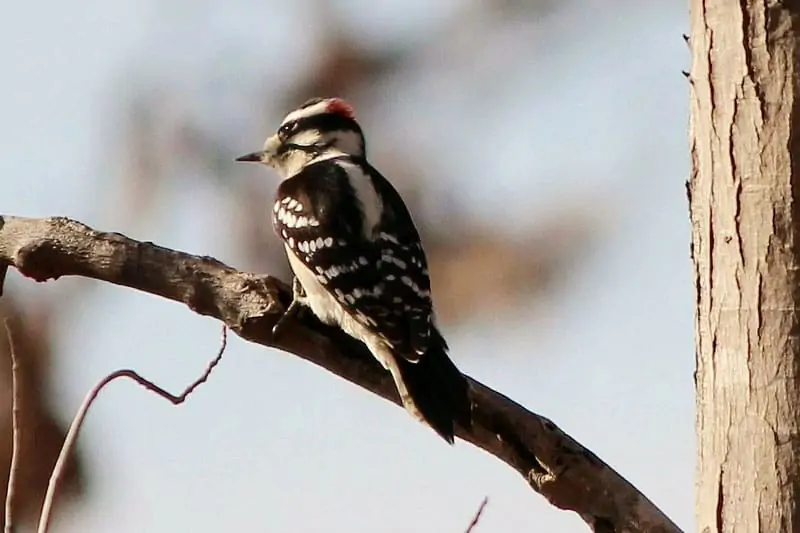With a total area of over 69, 899 square miles mostly dominated by vast plains, Oklahoma’s central position and mild weather allow for a diversified population of wildlife. This page contains a variety of different species of birds, however we’ll concentrate on the 11 woodpecker species that live in Oklahoma.
I’ll discuss where and when specific species may be found in Oklahoma, going over them one by one. We’ll also discuss a few woodpecker facts and provide you with photos of each species to help you identify them.
11 WOODPECKERS IN OKLAHOMA
Red-bellied Woodpecker, Red-headed Woodpecker, Downy Woodpecker, Yellow-bellied Sapsucker, Ladder-backed Woodpecker, Hairy Woodpecker, Northern Flicker, Pileated Woodpecker, Golden-fronted Woodpecker are among the 11 species of woodpECKERS found in Oklahoma.
1. RED-BELLIED WOODPECKER

Length: 9.4 in
Weight: 2.0-3.2 oz
Wingspan: 13.0 -16.5 in
The caps and napes of red-bellied woodpeckers are peachy-red with black and white striped backs. Throughout much of Oklahoma, woodpeckers may be found perched on the main branches and trunks of trees year-round, especially in woodlands and backyards.
They’ve also been spotted visiting backyard bird feeders from the woods. During the winter, use suet blocks to attract them, as well as peanuts and sunflower seeds. The insects inside dead trees are also appealing to them.
Learning the loud, rolling call of one of these birds is one of the best ways to locate them. During the spring and summer, they’re very active callers, so be on the lookout.
2. RED-HEADED WOODPECKER
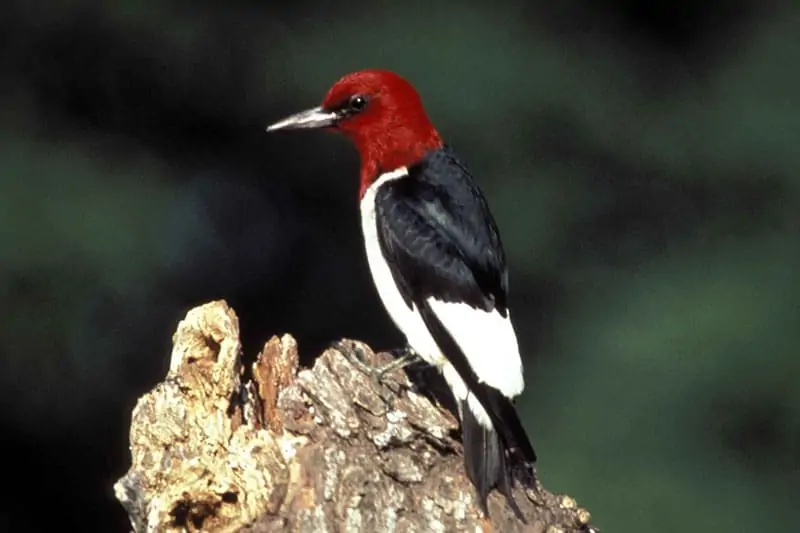
Length: 7.5-9.1 in
Weight: 2.0-3.2 oz
Wingspan: 16.5 in
Throughout most of Oklahoma, red-headed woodpeckers can be found year-round. Adults have black and white wings with bright red heads and a snow-white body. They are readily recognized. The plumage of juveniles is nearly all gray-brown, with white patches on their wings. Juveniles are less colorful.
Open woodlands, pine savannas, and swamps are preferred habitats for these woodpeckers. Their population is dwindling as a result of the loss of their habitats.
When compared to other woodpeckers, they are unique. In addition to drilling into wood, red-headed woodpeckers hunt for insects in the air. In their tree crevices, they also keep excess food like nuts and seeds.
3. DOWNY WOODPECKER

Length: 5.5-6.7 in
Weight: 0.7-1.0 oz
Wingspan: 9.8-11.8 in
In terms of size, Downy Woodpeckers are the smallest. They’re between a sparrow and a robin in size. In comparison to most other woodpeckers, their beaks seem shorter.
In Oklahoma, upy woodpeckers may be found in open woodlands and forests year-round. They may be seen in backyards, parks, and other residential regions, but they favor deciduous trees. They hammer away at trees during the spring and summer, producing their distinctive high-pitched whistles.
They frequently join mixed-species flocks throughout the winter. Because of their ability to team up with other tiny birds, they have more security and a better chance of finding food.
4. YELLOW-BELLIED SAPSUCKER
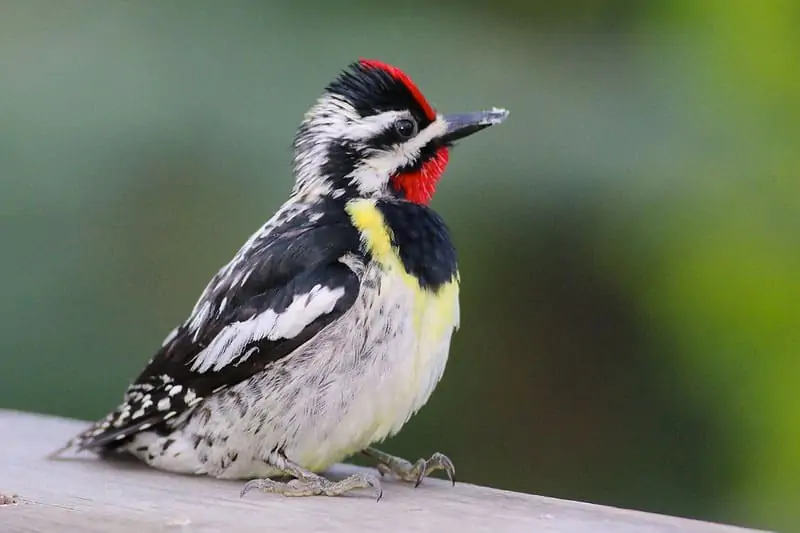
Length: 7.1-8.7 in
Weight: 1.5-1.9 oz
Wingspan: 13.4-15.8 in
Yellow-bellied Sapsuckers have a non-breeding winter population in Oklahoma, and each year in the warmer months, they migrate north to breed. They may be found up to 6,500 feet in elevation in young deciduous woodlands. They spend the winter in open woodlands.
On their foreheads and under their bills, they have large red markings. The remainder of their plumage is black and white, with their undersides being mostly white and occasionally yellowish.
The rows of sap-wells found in trees are good indicators of nearby Yellow-bellied Sapsuckers. These woodpeckers construct these small, neatly arranged holes there so they can drink the sap and other insects that escape with it.
5. HAIRY WOODPECKER

Length: 7.1-10.2 in
Weight: 1.4-3.4 oz
Wingspan: 13.0-16.1 in
In most of Oklahoma, hairy woodpeckers may be found year-round, however it’s important to differentiate between them and the downy woodpecker. The bills of Hairy Woodpeckers are longer and broader. They have a squarish head, black and white plumage, and a huge white patch down their backsides.
In mature forests, they may often be discovered on the trunks and major limbs of trees. They also stop by suet or sunflower seed feeders in the backyards. Listen for them to drum on drums while they forage, or hear their distinct whinny, “peek” call.
6. NORTHERN FLICKER
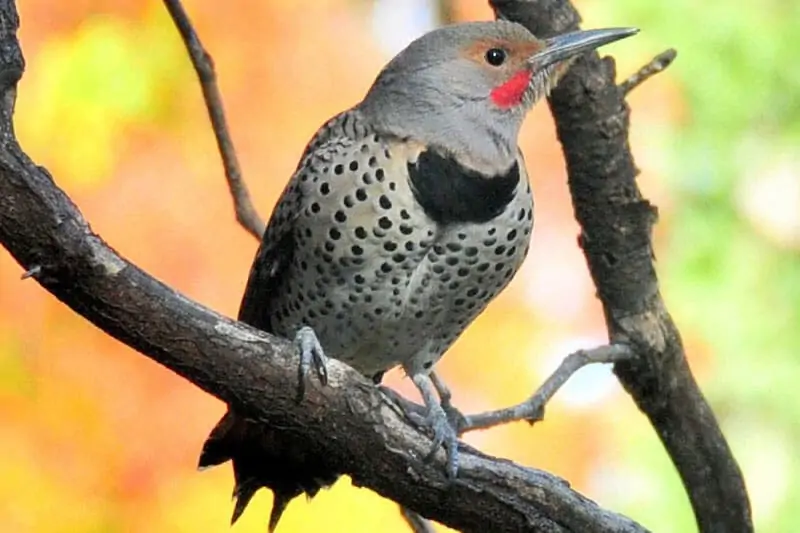
Length: 11.0-12.2 in
Weight: 3.9-5.6 oz
Wingspan: 16.5-20.1 in
In comparison to the white and black woodpeckers we’ve discussed, Northern Flickers are different. They have a silvery brown color and brilliant colors, red in the west and yellow in the west. They are rather big with a golden brown appearance. They have crescents and barring on the rest of their plumage, with dots on their undersides. They’re one of the most vibrant birds in North America.
Northern Flickers, unlike other woodpeckers, are frequently seen on the ground hunting for beetles and ants, their primary food. They live in open woods and the edges of forests throughout the year in Oklahoma. They’re often perched on branches while they’re not on the ground. Their terrifying howls and loud cries may be heard.
7. PILEATED WOODPECKER

Length: 15.8-19.3 in
Weight: 8.8-12.3 oz
Wingspan: 26.0-29.5 in
Pileated Woodpeckers are large Crow-sized birds with crimson triangular crests on their heads. They have lengthy beaks. Their heads and underside of their wings are striped with white, while their bodies are mostly black.
These woodpeckers aren’t as well-known as some of the other species on this list, but they may be found year-round in Oklahoma’s eastern third. Look for them in old woods with a lot of dead trees and fallen wood. Also look for excavations and distinctive rectangular holes in soft, rotting wood as a indication that these birds are present.
Listen for their whinny-like cries, which may help you identify them if you hear their loud pounding. Another way to attract birds is to keep suet in your backyard bird feeder.
8. LADDER-BACKED WOODPECKER

Length: 6.3-7.1 in
Weight: 0.7-1.7 oz
Wingspan: 13.0 in
From late January to March, look for Ladder-backed Woodpeckers during their mating season, which is more active. Just in the westernmost reaches of Oklahoma, Ladder-backed Woodpeckers may be found. Mealworms, peanut butter, and black oil sunflower seeds are readily accepted by them when offered at suet feeders, but they aren’t often seen.
If you want to attract a pair, don’t leave any dead trees in your yard alone. They commonly nest in dead trees. Because they often reside in deserts and thorn forests where cacti are abundant, ladder-backed Woodpeckers were once known as “Cactus Woodpeckers.”
9. RED-COCKADED WOODPECKER

Length: 7.9-9.1 in
Weight: 1.5-1.8 oz
Wingspan: 14.2 in
In a restricted number of places in the Southeast United States, the Red-cockaded Woodpecker may be found. They’re mainly found in the state’s southeastern corner when it comes to Oklahoma. These woodpeckers only nest and roost in pine trees, so look for them in forests with thick pine forests.
The Red-cockaded Woodpeckers are an endangered species that has been designated as a red watch list by the US Fish and Wildlife Service. Fish and Wildlife Service These birds are uncommon to encounter since they are endangered and no longer plentiful in the south as they were. Pine trees with heart fungus disease should be searched for. The wood becomes mushy as a result of this condition, making excavation simpler.
The backs and wings of red-cockaded Woodpeckers are striped with black and white stripes, while the top of their skulls are mostly white with black streaks. Males have a barely discernible crimson cockade, or stripe, around their cheekbones.
10. GOLDEN-FRONTED WOODPECKER

Length: 8.7-10.2 in
Weight: 2.6-3.5 oz
Wingspan: 16.5-17.3 in
The Golden-fronted Woodpecker is a year-round resident of Mexico and Central America. Yet, open woodlands and brushlands in central Texas, as well as portions of southern Oklahoma, are home to them. Insects, nuts, and seeds make up the majority of their food, with eggs from other birds thrown in for variety.
The barred black and white backs and yellow napes of both males and females make it difficult to determine who is who. The male has a bright red crown on his head. Only two locations in the United States are home to Golden-fronted Woodpeckers. Because they are less prevalent, little is known about them.
11. LEWIS’S WOODPECKER
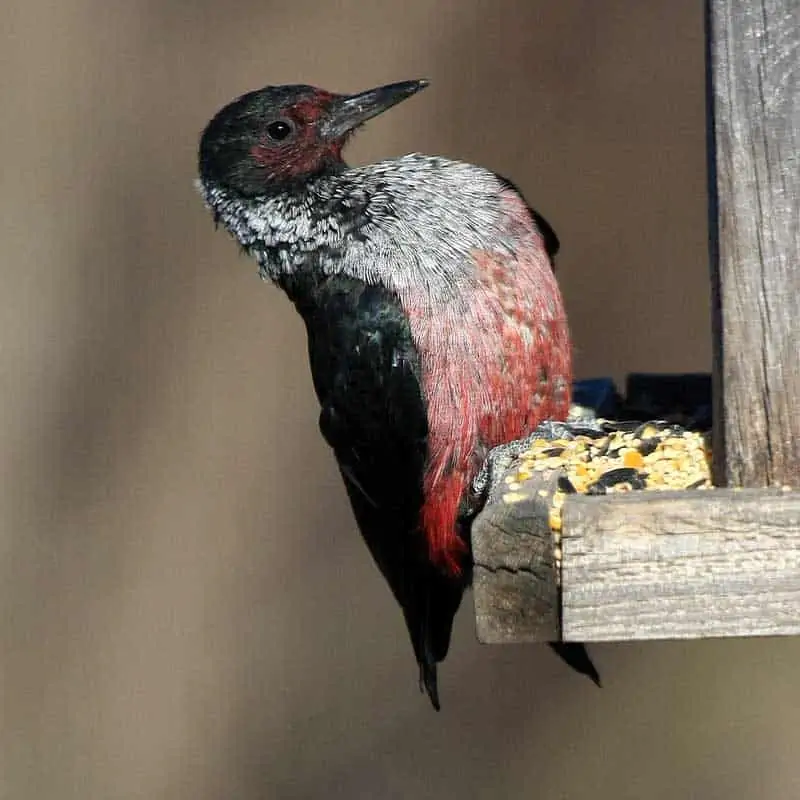
Length: 10.2-11.0 in
Weight: 3.1-4.9 oz
Wingspan: 19.3-20.5 in
Lewis’s Woodpeckers are exclusively found in the far western sections of Oklahoma’s panhandle and are not often seen in the state. Pine woodlands and woods that have been burnt are their favorite habitats.
Because they go around looking for stores of acorns and nuts during the breeding season, their populations are often unpredictable. During the winter, they store these foods in hidden places to last them.
Lewis’s Woodpeckers, like a number of other woodpeckers, feed on insects in the air rather than on trees. Their flight has a beautiful, crow-like quality due to their large, rounded wings. A pink belly, a red patch on the head, and a dark, iridescent green on their back and wings make them stand out.
HOW TO ATTRACT WOODPECKERS
Attracting woodpeckers to our feeders or yards is something we enjoy for many people. They bring a bit of excitement to the table and are just as common as chickadees, titmice, or cardinals. However, they are more difficult to detect and attract. Here are some advice for getting woodpeckers to visit your property.
- Several types of woodpeckers are known for feeding at bird feeders, so offer them what they like. Consider putting up a black sunflower seed feeder as well as offering suet. Large woodpeckers will be attracted by a suet feeder with a tail prop zone.
- Woodpeckers prefer dead and dying trees that are simple to bore holes in and provide plenty of insect larvae for them to devour. Leave dead trees alone.
- Many woodpecker species will utilize nest boxes. Place them up. From May to July, pileated woodpeckers utilize nesting holes.
- Woodpeckers may occasionally enjoy fruits and berries like dogwood, serviceberry, tupelo, mountain ash, strawberry, cherry, grapes, bayberry, holly, blueberries, apples and mulberry.
- Woodpeckers, like other birds, will utilize bird baths if there is no water source available. Don’t forget the water; have a water source accessible, and preferably one that includes a water mover or solar fountain to entice them. Batteries on solar fountains perform best when the fountain isn’t constantly stopped by the sun disappearing behind a cloud.
